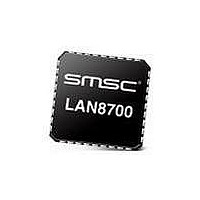LAN8700I-AEZG SMSC, LAN8700I-AEZG Datasheet - Page 8

LAN8700I-AEZG
Manufacturer Part Number
LAN8700I-AEZG
Description
Ethernet ICs HIPERFRM ETHRNT PHY
Manufacturer
SMSC
Type
MII/RMII Ethernet Transceiverr
Datasheet
1.LAN8700C-AEZG.pdf
(80 pages)
Specifications of LAN8700I-AEZG
Ethernet Connection Type
10 Base-T, 100 Base-TX
Minimum Operating Temperature
0 C
Mounting Style
SMD/SMT
Product
Ethernet Transceivers
Number Of Transceivers
1
Standard Supported
802.3ab
Data Rate
10 Mbps, 100 Mbps
Supply Voltage (max)
3.3 V
Supply Voltage (min)
1.8 V
Supply Current (max)
39 mA, 81.6 mA
Maximum Operating Temperature
+ 70 C
Package / Case
QFN-36
Lead Free Status / RoHS Status
Lead free / RoHS Compliant
Chapter 1 General Description
Revision 2.2 (12-04-09)
1.1
Controller
or SOC
Access
10/100
(MAC)
Media
The SMSC LAN8700/LAN8700i is a low-power, industrial temperature (LAN8700i), variable I/O voltage,
analog interface IC with HP Auto-MDIX support for high-performance embedded Ethernet applications.
The LAN8700/LAN8700i can be configured to operate on a single 3.3V supply utilizing an integrated
3.3V to 1.8V linear regulator. An option is available to disable the linear regulator to optimize system
designs that have a 1.8V power plane available.
The LAN8700/LAN8700i consists of an encoder/decoder, scrambler/descrambler, wave-shaping
transmitter, output driver, twisted-pair receiver with adaptive equalizer and baseline wander (BLW)
correction, and clock and data recovery functions. The LAN8700/LAN8700i can be configured to
support either the Media Independent Interface (MII) or the Reduced Media Independent Interface
(RMII).
The LAN8700/LAN8700i is compliant with IEEE 802.3-2005 standards (MII Pins tolerant to 3.6V) and
supports both IEEE 802.3-2005 compliant and vendor-specific register functions. It contains a full-
duplex 10-BASE-T/100BASE-TX transceiver and supports 10-Mbps (10BASE-T) operation on
Category 3 and Category 5 unshielded twisted-pair cable, and 100-Mbps (100BASE-TX) operation on
Category 5 unshielded twisted-pair cable.
Hubs and switches with multiple integrated MACs and external PHYs can have a large pin count due
to the high number of pins needed for each MII interface. An increasing pin count causes increasing
cost.
The RMII interface is intended for use on Switch based ASICs or other embedded solutions requiring
minimal pincount for ethernet connectivity. RMII requires only 6 pins for each MAC to PHY interface
plus one common reference clock. The MII requires 16 pins for each MAC to PHY interface.
The SMSC LAN8700/LAN8700i is capable of running in RMII mode. Please contact your SMSC sales
representative for the latest RMII specification.
The LAN8700/LAN8700i referenced throughout this document applies to both the commercial
temperature and industrial temperature components. The LAN8700i refers to only the industrial
temperature component.
Architectural Overview
Figure 1.1 LAN8700/LAN8700i System Block Diagram
MII /RMII
System Bus
±15kV ESD Protected MII/RMII 10/100 Ethernet Transceiver with HP Auto-MDIX Support and flexPWR
25 MHz (MII) or 50MHz (RMIII)
Crystal or External Clock
DATASHEET
LAN8700/
LAN8700I
SMSC
8
Magnetics
LEDS/GPIO
SMSC LAN8700/LAN8700i
®
Technology in a Small Footprint
Ethernet
Datasheet













